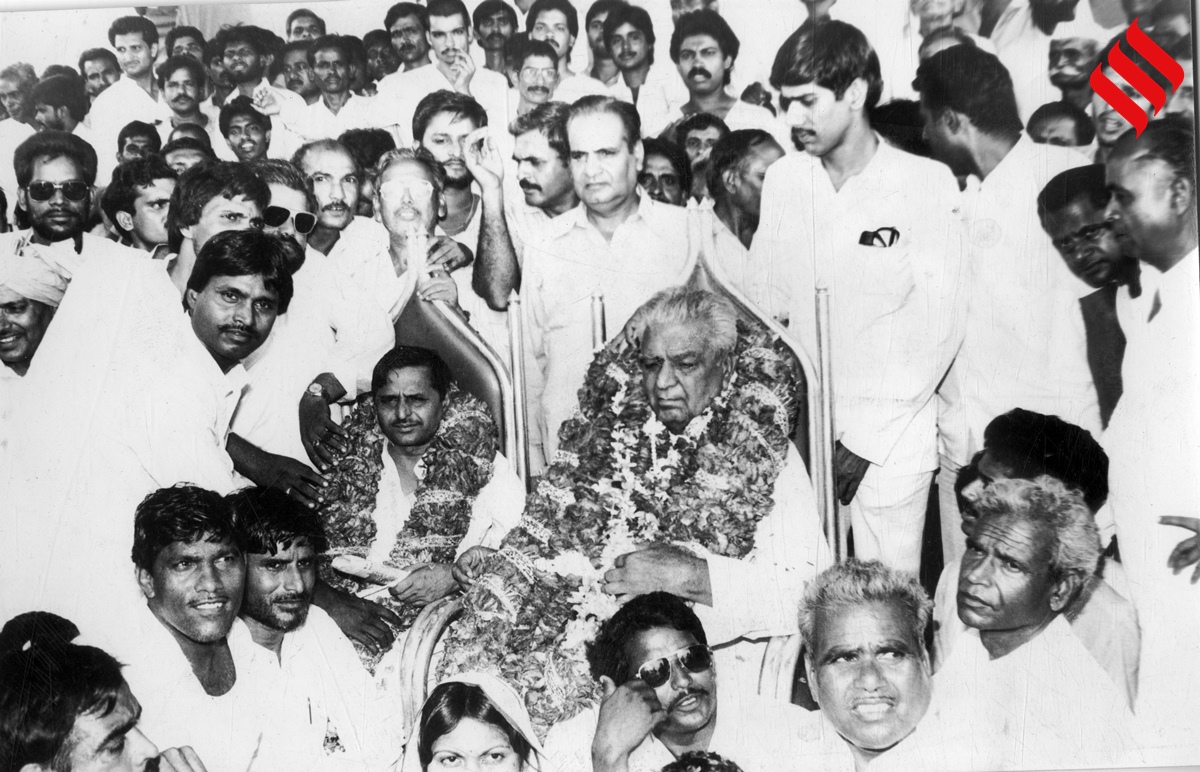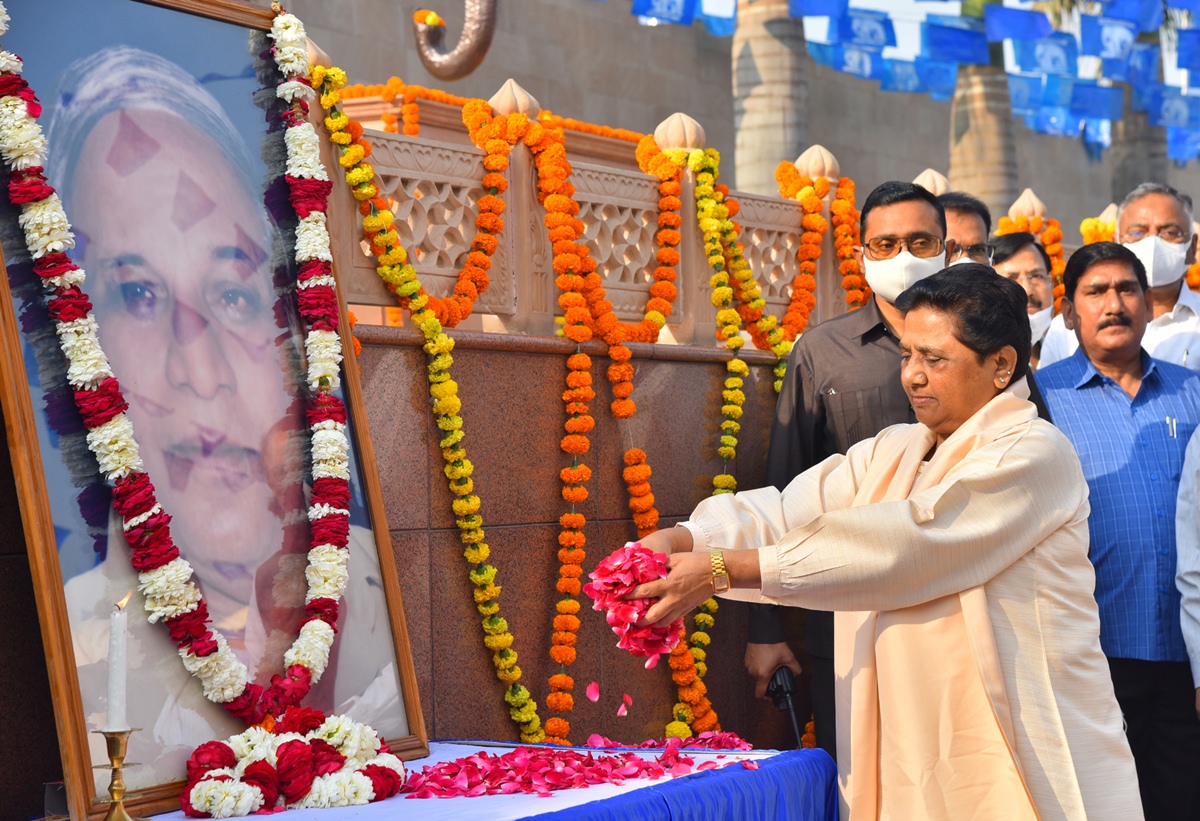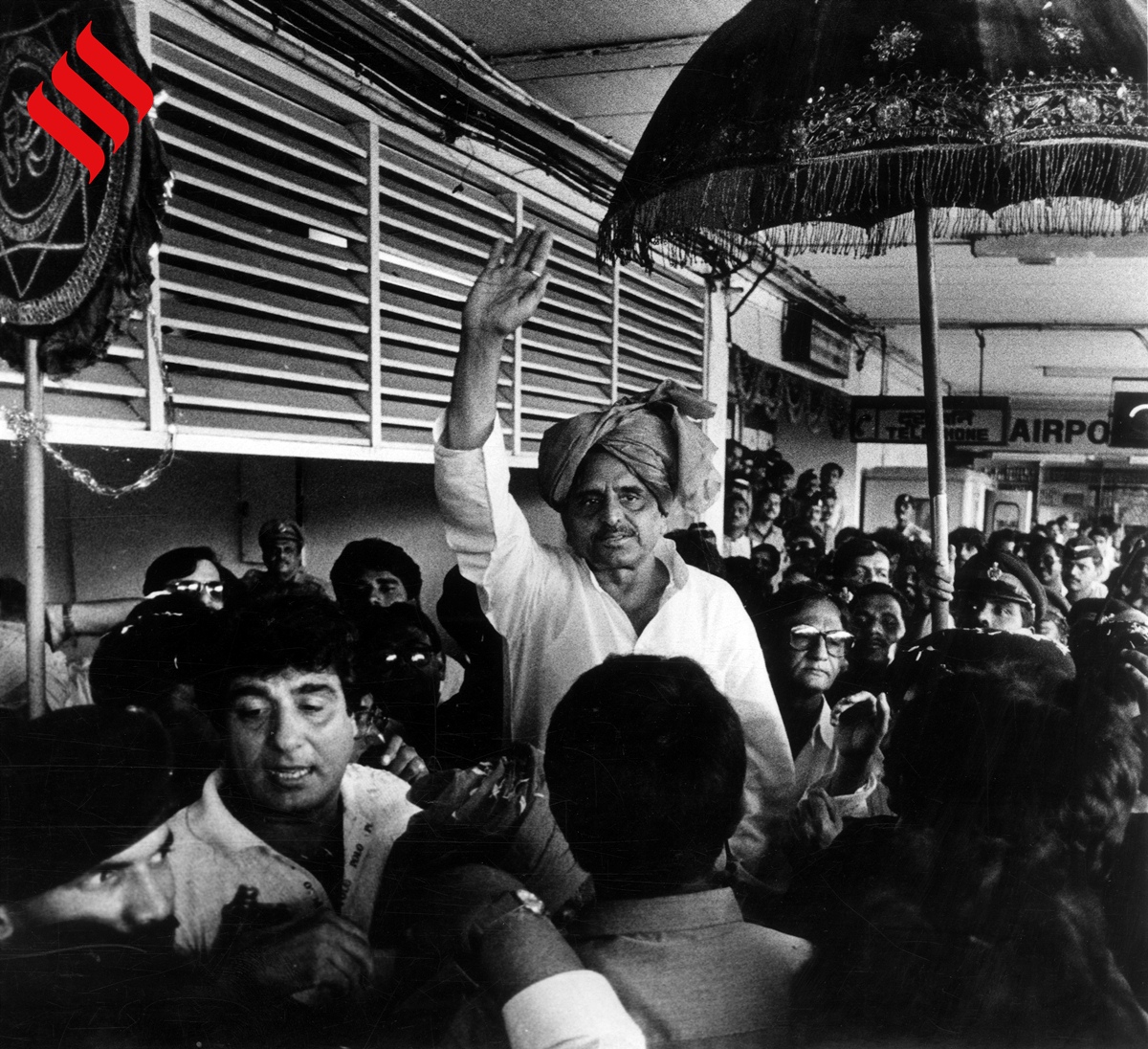Unveiling a statue of Bahujan Samaj Party (BSP) founder Kanshi Ram in Rae Bareli Monday, Samajwadi Party president Akhilesh Yadav said the “samajwadi movement” launched by his father and SP founder late Mulayam Singh Yadav and the path shown by socialist leader Ram Manohar Lohia was the same as the one shown by B R Ambedkar and Kanshi Ram.
Accompanied by SP leader Swami Prasad Maurya, who was earlier with the Lok Dal, BSP and BJP, Akhilesh pointed out that Kanshi Ram won his first Lok Sabha election in 1991 from Etawah, the Yadav family’s home turf, following which “a new politics started in UP”.

Years before the BSP and SP forged an alliance for the 1993 UP Assembly polls, both Kanshi Ram and Mulayam had already travelled a long distance in politics.
 BSP leader Kanshi Ram addressing the rally. (Express archive photo)
BSP leader Kanshi Ram addressing the rally. (Express archive photo)
By getting the Congress’s key support bases, the Scheduled Castes (SCs) and the minorities, into their respective folds, the BSP and the SP had scripted the end of the grand old party’s rule in UP, although they could not come to power on their own steam initially given the limits of their social bases.
A look at the history of the BSP-SP relationship shows that the founders of both the parties decided to join hands with each other after realising these limits of their parties’ strengths.
Mulayam had formed the SP in October 1992 after deserting VP Singh and then Chandra Shekhar. Kanshi Ram founded the BSP in 1984 following his social engineering experiments under his DS-4 (Dalit Shoshit Samaj Sangharsh Samiti). He had also laid down his idea of politics in his book “Chamcha Yug (The era of stooges)”. Even before the BSP was formed, its leaders were contesting as Independents in various elections.
Mulayam joined politics in mid-Sixties in Ram Manohar Lohia’s Sanyukt Socialist Party (SSP) before shifting to the BKD (of Charan Singh), Janata Party (formed after merger of several outfits), Lok Dal (Charan Singh), Lok Dal-B (of H N Bahuguna), Janata Dal (of V P Singh), and to the Janata Party (of Chandra Shekhar).
Story continues below this ad
 Samajwadi party leader Mulayam Singh Yadav and Chaudhary Devi Lal. (Express archive photo)
Samajwadi party leader Mulayam Singh Yadav and Chaudhary Devi Lal. (Express archive photo)
He then went on to found his own party SP. Interestingly, its name “Samajwadi Party” was reportedly suggested by Keshrinath Tripathi, BJP leader and former UP Assembly Speaker.
Mulayam had however gauged the BSP’s power much earlier. In the 1991 Lok Sabha polls, which were held after the collapse of the Chandra Shekhar government, he persuaded Kanshi Ram to contest from Etawah and did not field a candidate against him. Mulayam’s relations with the then Janata Dal leader V P Singh had worsened and he had joined the party’s Chandra Shekhar faction after its split. For his new political innings, he was looking for new alignments.
Kanshi Ram had contested his first Lok Sabha poll from Janjgir-Champa (now in Chhattisgarh) in 1984 as an Independent. Mayawati, his close associate, was then fielded from UP’s Kairana. Both of them lost, with Kanshi Ram getting 8.81 per cent of the polled votes and Mayawati getting 9.94 per cent votes.
In 1985, Mayawati contested the Bijnore Lok Sabha bypoll and again lost but got 18 per cent votes and came third after the winner Meira Kumar (daughter of Jagjivan Ram) of the Congress and Ram Vilas Paswan (another Dalit leader from Bihar) of the Lok Dal.
Story continues below this ad
Kanshi Ram contested the 1988 Lok Sabha bypoll against V P Singh from Allahabad. In 1989, he contested against then Congress chief and Prime Minister Rajiv Gandhi in Amethi and against H K L Bhagat in East Delhi. He lost these polls.
However, in the 1989 UP Assembly polls, the BSP contested 372 of the state’s total 425 seats and secured 13 seats and 9.41 per cent votes. The party had then extended its support to the Mulayam Singh-led government from outside. In the 1991 UP Assembly polls too, despite the BJP wave, the BSP managed to garner 12 seats and 9.44 per cent votes.
 BSP Supreemo Mayawati paying tribute to Bahujan Samaj Party founder Kanshi Ram on the occasion of his birth anniversary (Express phot by Vishal Srivastav)
BSP Supreemo Mayawati paying tribute to Bahujan Samaj Party founder Kanshi Ram on the occasion of his birth anniversary (Express phot by Vishal Srivastav)
After Independence, the SC communities primarily voted for the Congress till the early 1980s, following which sizeable sections of them started switching to the BSP in the Hindi heartland, especially UP.
In the 1989 Lok Sabha polls, the BSP won three seats with Mayawati winning from Bijnore.
Story continues below this ad
Kanshi Ram could however clinch his first Lok Sabha poll win only in 1991 with Mulayam’s help from Etawah. As a quid pro quo that year which saw simultaneous Lok Sabha and UP Assembly polls, the BSP then did not field its candidate against Mulayam in the Jaswantnagar Assembly seat.
Barely two months after the SP’s formation, the Kalyan Singh-led BJP government was dismissed and President’s rule imposed in UP on December 6, 1992, after the demolition of Babri Masjid. The BJP was expecting sympathy from voters over it, even as the party’s governments in Madhya Pradesh, Rajasthan and Himachal Pradesh were also dismissed but the then Congress-led central government headed by PM PV Narsimha Rao ensured that the Assembly polls in these states would be held only by 1993-end.
The Rao government had appointed ex-Madhya Pradesh CM and Congress veteran Motilal Vora as the UP Governor.
The BJP’s expected sympathy factor was perceived to be waning with the passage of time, even as the BSP and the SP had started looking for expanding their bases while seeking new allies.
Story continues below this ad
 SP chief Akhilesh Yadav unveils a statue of Kanshi Ram on April 3 (Twitter)
SP chief Akhilesh Yadav unveils a statue of Kanshi Ram on April 3 (Twitter)
Both the BSP and the SP joined hands to fight the 1993 UP Assembly polls together. The SP contested 256 seats and won 109, whereas the BSP contested 164 seats and won 67. With Dalits and OBC voters supporting their coalition, the two parties got the better of the BJP in the hung Assembly, although the latter emerged as the single largest party with 177 seats.
With some other parties including the Congress extending their support to the SP-BSP alliance, Mulayam Singh was sworn in as the CM, for the second time, on December 4, 1993.
Within a few months into their coalition government, however, rifts between the SP and the BSP surfaced. Seeking to expand its footprint, the BSP started consolidating its Dalit support base while reaching out to some of the most backward communities, thereby pressuring Mulayam to guard his base.
The game of UP power politics started heating up in Delhi too. On May 31, 1995, Jayant Malhotra, a BSP Rajya Sabha MP and a businessman close to Kanshi Ram, said Mulayam will be out of power soon. In July 1994, Kanshi Ram had also threatened to withdraw from the government but that did not fructify.
Story continues below this ad
On June 1, 1995, however, the BSP pulled the plug on the government. Governor Vora asked Mulayam to resign, but he declined to step down. Meanwhile, the BSP suffered a split as 25 MLAs of the party, led by Raj Bahadur, broke away to form a splinter outfit called the BSP (R).
Subsequently, the infamous Lucknow VVIP guest house incident took place, when several BSP legislators including Mayawati, who were holding their meeting there, were allegedly beaten by many SP leaders and goons.
On June 3, 1995, the Centre dismissed the Mulayam government. On the same day, the BJP leaders met Governor Vora to offer their party’s support for a BSP-led government, even as Mulayam also met Vora to offer his support to a government led by Raj Bahadur.
 Samajwadi party leader Mulayam Singh Yadav and Raj Babbara at a rally in August 1995. (Express archive photo by Mohan Bane)
Samajwadi party leader Mulayam Singh Yadav and Raj Babbara at a rally in August 1995. (Express archive photo by Mohan Bane)
The Governor however invited Mayawati to form her government with the support of the BJP. There were however also differences within the BJP over extending support to the BSP-led government, with Kalraj Mishra and Lalji Tandon backing Mayawati while Kalyan Singh being opposed to it.
Story continues below this ad
Their coalition government however also could not last long. The BJP withdrew support from the Mayawati government on October 17, 1995, following which the Assembly was dissolved.
In the 1996 Lok Sabha polls, Kanshi Ram, anticipating hurdles in Etawah, shifted to the Hoshiarpur seat in Punjab and Phulpur in UP. He won only from Hoshiarpur though. In the 1998 polls, he also contested from UP’s Saharanpur but lost. That was the last election he contested.
The BSP suffered three major defections in UP – in 1995, 1997 and 2003. Two of them (1995 and 2003) were allegedly engineered by the SP and one (1997) allegedly by the BJP. Since the mid-nineties, the history of relationship between the SP and the BSP has been largely bitter and hostile, with their governments reversing major decisions taken by the other one or “victimising” the other’s supporters, and their members filing cases against each other.
During its tenure during 2012-17, the Akhilesh Yadav government did not support reservation for the Scheduled Castes in promotions in government.
Story continues below this ad
However, following the BJP’s victory by landslide in the 2017 UP Assembly polls, alliance talks again started between the SP and the BSP leaders. After Kanshi Ram’s demise, Mayawati ruled the state during 2007-2012 with the support of Brahmins. She had then sought to project the BSP as a party of “Sarvjans (all people)” rather than just of “Bahujans (deprived sections)”. The Akhilesh government also had the support of a section of the upper castes including Brahmins.
For the 2019 Lok Sabha polls the BSP and the SP forged an alliance, called “Mahagathbandhan”, that involved seat-sharing. Mayawati addressed rally in Mainpuri in support of Mulayam’s candidature, even as she also decided to withdraw some criminal cases she had filed against him. While the BSP won 10 seats, the SP could win just five in the polls, following which their ties were broken. Even Akhilesh’s family members, including his wife Dimple Yadav (Kannauj) and his cousin Dharmendra Yadav (Badaun) had lost in this election.
As part of its social engineering, the BJP weaned a slew of leaders from the SP (especially non-Yadav OBCs and Thakurs) and from the BSP (especially SCs and Brahmins), while reducing both parties to their core vote base.
In the 2022 UP Assembly polls, the BSP was decimated, finishing with just one seat, even as the BJP has continued to make a vigorous outreach to different SC communities. With its support bases among Muslims, Yadavs and some other sections being broadly intact, the SP seems to be in a better position as it emerged as the largest Opposition party with 111 seats. It is a different matter that the SP’s outreach to Dalit communities is still perceived to be an “exercise in symbolism”.



 BSP leader Kanshi Ram addressing the rally. (Express archive photo)
BSP leader Kanshi Ram addressing the rally. (Express archive photo) Samajwadi party leader Mulayam Singh Yadav and Chaudhary Devi Lal. (Express archive photo)
Samajwadi party leader Mulayam Singh Yadav and Chaudhary Devi Lal. (Express archive photo) BSP Supreemo Mayawati paying tribute to Bahujan Samaj Party founder Kanshi Ram on the occasion of his birth anniversary (Express phot by Vishal Srivastav)
BSP Supreemo Mayawati paying tribute to Bahujan Samaj Party founder Kanshi Ram on the occasion of his birth anniversary (Express phot by Vishal Srivastav) SP chief Akhilesh Yadav unveils a statue of Kanshi Ram on April 3 (Twitter)
SP chief Akhilesh Yadav unveils a statue of Kanshi Ram on April 3 (Twitter) Samajwadi party leader Mulayam Singh Yadav and Raj Babbara at a rally in August 1995. (Express archive photo by Mohan Bane)
Samajwadi party leader Mulayam Singh Yadav and Raj Babbara at a rally in August 1995. (Express archive photo by Mohan Bane)





























